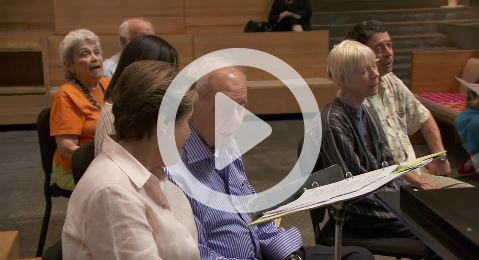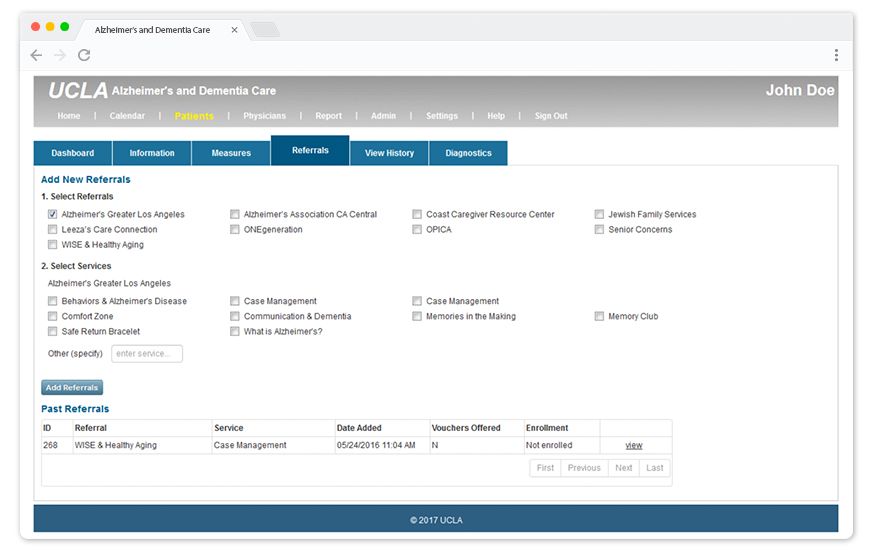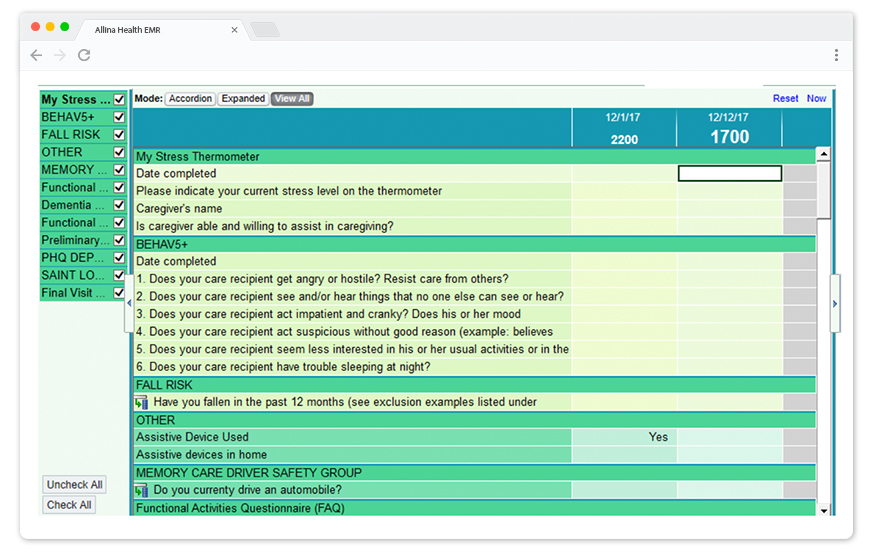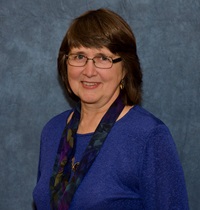In parts of the country that lack specialized care centers for patients with Alzheimer’s disease and other forms of dementia, newly diagnosed patients and their loved ones struggle to manage what can be a long, progressive decline. Several innovative dementia care models show how, in the absence of a cure, providers can help patients and family caregivers cope with the physical symptoms of dementia, monitor its effects on other chronic conditions, and offer strategies for behavioral and psychosocial problems. Recently added Medicare billing codes for dementia care planning and for an annual wellness visit that requires clinicians to offer cognitive screening may encourage more clinicians to identify dementia and help patients and families with next steps after a positive diagnosis.
By Martha Hostetter and Sarah Klein
As the population ages, more Americans will develop chronic conditions that lead to disability and frailty in their later years.1 Among the most-feared conditions of old age, dementia often tops the list: it cannot be prevented, has no known cure, and places enormous emotional, logistical, and financial burdens on family caregivers. Much attention has been focused on finding a cure for Alzheimer’s disease, as well as other forms of dementia, but this has proven elusive. “Over 10 years, more than 240 compounds were tested for effectiveness against Alzheimer’s disease but only one drug has made it to market,” says David Reuben, M.D., director of the University of California, Los Angeles, Alzheimer’s and Dementia Care Program. “It’s a very wily disease.” Meanwhile, he and other experts say, not enough attention has been focused on spreading proven models of care to support the more than 5 million Americans living with dementia and their families.2
This issue of Transforming Care looks at some promising approaches to dementia care and explores ways they might be spread. Many have emerged from academic medical centers around the nation, including the University of Arizona/Banner–University Medical Center, Indiana University and its safety-net partner Eskenazi Health, Johns Hopkins University, the University of California, Los Angeles (UCLA), and the University of California, San Francisco (UCSF). While their techniques differ, the programs developed by these institutions go beyond services provided by most dementia specialty centers — which tend to offer mainly diagnosis and referrals to outside organizations — to help patients and their family caregivers in five key ways: assessing their needs, offering anticipatory guidance and helping them make plans as the disease progresses, managing the physical symptoms of dementia and any other chronic conditions, offering strategies to cope with behavioral and psychosocial problems, and making warm handoffs to community support services. Their core features are described below.
Innovative Dementia Care Models
Fielding Interdisciplinary Teams
These programs provide services through interdisciplinary teams, which include varying combinations of geriatricians, neurologists, nurse practitioners, nurses, and social workers, to address patients and families’ diverse and evolving needs. Many also use specially trained lay workers to offer support. For example, at Johns Hopkins University’s Maximizing Independence (MIND) at Home program, “memory care coordinators” help families navigate their medical care, build skills to manage dementia, and connect with social services. “Their role is to problem-solve and to educate families about what to expect and to show compassion and caring,” says Quincy Samus, Ph.D., an associate professor of psychiatry and behavioral sciences and principal investigator of a trial of the MIND at Home intervention.
At the University of Arizona Center on Aging, community health workers from rural, Spanish-speaking, and tribal communities are trained to engage patients and their families in goals-of-care conversations that recognize different cultural views of dementia. “Certain groups, including some American Indians and Alaska Native populations, may feel dementia is more of a spiritual journey toward the end of life and that only calling it a disease is inappropriate and wrong,” says Mindy Fain, M.D., a geriatrician and codirector of the Arizona Center on Aging. “If we in health care simply focus on the medical model, we can alienate people who have their own belief systems and different world views.”
The interdisciplinary teams mainly work together in specialty clinics, though there are efforts to embed parts of the models in primary care (at Eskenazi and UCLA) and bring some services to patients in their homes (through Johns Hopkins’ MIND at Home and the Healthy Together Care Partnership, a home-care program run by the University of Arizona Health Plans/Banner Health).
Proactively Managing Care
Multiple studies have found that dementia presents risks to patients’ overall health: those with dementia are more likely than other older adults to be hospitalized for conditions that might have been treated in outpatient settings, such as dehydration, urinary tract infection, or pneumonia, and therefore have much higher health care costs.3 Dementia care management programs seek to partner with patients’ primary and specialty care providers to monitor their chronic conditions.
Some programs focus on people in nursing homes, where 40 percent of long-stay residents have dementia. The University of Indiana’s OPTIMISTIC (Optimizing Patient Transfers, Impacting Medical Quality, and Improving Symptoms: Transforming Institutional Care) program, part of a Center for Medicare and Medicaid Innovation (CMMI) demonstration aimed at reducing the number of nursing home residents transferred to hospitals, embeds registered nurses in nursing homes to offer staff training and support. Dementia is a key area of focus because for these individuals hospitalization can be destabilizing and contribute to delirium, falls, and other complications. (One study found that older adults with dementia are much more likely than other older adults to experience transfers in and out of hospitals, nursing homes, and their own homes.4) The registered nurses help nursing home staff (mainly licensed practical nurses or clinical nursing assistants) manage conditions like pneumonia that can lead to hospitalizations, sometimes because they are not detected in a timely manner. “Patients with dementia can be difficult to assess because they often can’t tell you how they are feeling,” says Kathleen Unroe, M.D., M.H.A., center scientist at the Indiana University Center for Aging Research. “Our nurses train staff to discover any signs or symptoms that might explain a change in behavior. Do they have a new cough? They need to do a full exam and pick up on the cues to identify the cause.”
Managing Psychological and Behavioral Issues
In addition to their problems with recognition, recall, sequencing, and other cognitive deficits, people with dementia may develop delirium, depression, and/or anxiety for which they are prescribed drugs such as benzodiazepines and antipsychotics that may exacerbate their symptoms or introduce other risks. “Somewhere from 25 percent to 50 percent of people with dementia are getting bad medication,” says Malaz Boustani, M.D., M.P.H., director and chief innovation and implementation officer at the Sandra Eskenazi Center for Brain Care Innovation.5 Clinicians in these programs emphasize nonpharmacologic treatment for behavioral problems. The Eskenazi Health Aging Brain Care Program Boustani helps to run educates caregivers about the potential triggers of unwanted behaviors and strategies to defuse them, including by making changes to the home environment, creating reassuring routines, and using simple language and visual cues.
Some of the programs also recommend activities such as Music and Memory, which encourages the use of personalized music playlists to trigger memories that can comfort those with dementia.

Family Caregiver Support
Many care management programs regard family caregivers as their patients, too, given that the high burdens placed on them can exact a toll. Among the 44 million Americans unpaid family caregivers, 8.5 million are caring for people with dementia — and they are twice as likely as other caregivers to report their role has taken a toll on their physical health, emotional state, employment, finances, or family relationships.
Caregivers for patients with dementia have higher mortality than caregivers for those with other diseases, and much higher mortality rates than the general population.6
At NYU School of Medicine, Mary S. Mittelman, Dr.P.H., has developed the NYU Caregiver Intervention, which begins with an in-depth assessment of caregivers’ physical health, stress level, emotional state, and family functioning. Counselors then offer two individual sessions and four family sessions to help caregivers work through areas of conflict and develop coping strategies. “One man found it too upsetting to visit his father,” says Mittelman. “So the counselor said what are you willing to do and he said well I can bring groceries to the house and mow the lawn. And that was the opening wedge, and he was slowly able to get involved.” Participants are also advised to take part in a support group and can reach counselors by telephone to deal with changing circumstances or crises.
At UCSF, social workers in the Care Ecosystem program help families make short- and long-term plans, including proactively addressing issues like finances and wills. This is especially important for those with frontotemporal dementias, which can progress very quickly and affect the parts of the brain related to judgment and empathy. “Left to their own devices, people with frontotemporal dementia will almost always lose the family’s savings,” says Bruce Miller, M.D., professor of neurology at UCSF and director of its dementia center.
Links with Community-Based Support Services
Programs have found various ways to connect dementia patients and family caregivers with community-based support services, including respite or adult day care, support groups, transportation, and educational resources. At UCLA, dementia care managers look through an inventory of available services then refer patients to particular organizations, whose services they pay for through a voucher system (initially funded by a CMMI grant and later through philanthropy) if families have inadequate funds.

Minneapolis-based Allina Health is piloting a new referral tool that enables primary care clinicians to use a “consult” button in their electronic health record system to refer patients to one of three organizations: the local chapter of the Alzheimer’s Association, the Area Agency on Aging, and a nonprofit, Family Pathways, which offers respite, companionship, meals, transportation, education, and Memory Cafes.7 These three organizations then reach out to patients to help them identify their needs and connect them with their own or other services offered in the community. “We tell patients and families that they will be getting a call from whichever organization makes the most sense for them,” says Kathleen Woo-Rippe, M.D., a family medicine physician at Allina. “We don’t depend on families to make the call because we know many mean to but won’t do so.”8

Effects of Dementia Care Management Programs
Several of these programs have been shown to improve patient and caregiver experiences, ameliorate behavioral problems, reduce acute care use, and delay nursing home entry. A trial of Eskenazi Health’s program found that after 12 months patients had fewer hospitalizations and emergency department visits, leading to net savings in the range of $980 to $2,800 per patient per year.9 A trial of the MIND at Home approach found that it significantly prolonged the length of time that people with dementia could be cared for in their homes (the median duration was 288 days longer for the intervention than the control group). Participants were also more likely to have their needs met related to safety and advance care planning, and to rate their quality of life higher after 18 months.10 And preliminary data from an evaluation of UCLA’s model found that it saved Medicare about $2,000 per patient per year.11
Specific approaches to support family caregivers also have proven effective. Early results from a CMMI-funded trial of UCSF’s Care Ecosystem found that 92 percent of caregivers would recommend it to others; among those who used it to find community resources, 87 percent said those referrals were helpful.12 “One of the things we’ve noticed is that the lower the socioeconomic status of the family, [the greater the social need] and the more programs like Care Ecosystem benefit them,” says Miller. And a trial of the NYU Caregiver Intervention found less of a decline in caregivers’ self-reported physical and emotional health among those receiving counseling to improve family dynamics and other supports.13 Caregivers in the program were able keep their loved ones home for 1.5 years longer than those in the usual care group.14
Scaling Innovative Dementia Care Models
Timely Detection and Care Planning
Spreading innovative approaches to dementia care must begin with timely detection by primary care clinicians, who are well positioned to recognize problems and much more accessible than specialty dementia centers.15 Dementia is often diagnosed late in the course of the illness, sometimes after a crisis (e.g., financial mismanagement or a car crash) and often too late to enable patients to fully participate in planning their care.16 Part of the reason is that even if primary care clinicians suspect a problem, they may be reluctant to suggest cognitive screening out of concern that they will burden families with news of a devastating disease for which there is no known cure. The U.S. Preventive Services Task Force’s 2014 statement that the current evidence is insufficient to balance the potential benefits and harms of cognitive screening may also have had a chilling effect, says Soo Borson, M.D., principal at Dementia Care Research and Consulting and former director of University of Washington’s Memory Disorders Clinic. “While it’s true that we have not found widely applicable ways to reverse or slow declines,” she says, “screening is important because dementia affects patients’ compliance with treatment and understanding of treatment choices. At the Memory Disorders Clinic I had too many patients telling me they knew what their medications were but when I asked what they were they had no idea.”
Borson developed the Mini-Cog — a simple screening instrument in which patients are asked to recall words and draw a clock face — to help primary care clinicians detect whether patients may have some cognitive impairment and therefore need extra support in managing their conditions.
Since 2011, Allina Health has used the Mini-Cog to offer cognitive screening during annual wellness visits for Medicare beneficiaries. Starting this year, Allina built tools to leverage the new Medicare dementia care planning benefit to help patients and families after a positive screen.17 Patients are asked to return to their primary care clinic with a friend or family member to have an extensive evaluation of their cognitive and physical functioning, safety, psychiatric and behavioral symptoms, as well as their medications and other chronic conditions. Notably, the evaluation also requires clinicians to assess the needs and abilities of the caregiver — the first official acknowledgement by Medicare of the key role of caregivers in managing the disease. For efficiency, some of these assessments are performed by nursing assistants. The result of this comprehensive evaluation is a written care plan, which is shared with the patient and their family members during a subsequent visit and becomes part of their electronic medical record.
Spreading Care Models Through Technology
There are also efforts to spread innovative approaches to dementia care through technology. UCSF’s Care Ecosystem — a telephone and web-based support program that offers round-the-clock support, education, and remote monitoring via smartphones and home sensors — is a deliberate attempt to scale dementia services by minimizing the need for in-person visits. At Eskenazi Health, Boustani’s team plans to leverage artificial intelligence to help field questions from patients and families and provide information on demand. The Cleveland-based Benjamin Rose Institute on Aging, a research and service organization that led some of the earliest research into family caregiving, has developed BRI Care Consultation, a personalized coaching program delivered by phone or email through which a nurse, social worker, or nonclinician helps people with dementia and their caregivers develop and execute action plans. One goal of the program is to empower caregivers to speak up, for example by making lists of topics they’d like to cover with their loved one’s clinicians or by assigning particular tasks to friends and other family members. In use in 35 sites across the country, including Area Agencies on Aging, Alzheimer’s Associations, family counseling agencies, and a few health systems, the program has been associated with reduced emergency department use and hospitalizations among patients with various conditions, including dementia.18
We need more models of care that identify dementia in health care settings and create a plan of care that is community based, taking advantage of all types of available support. Family homes are where we should strive to keep older adults and their family caregivers physically and emotionally supported.
Alternative Payment Models
Given that dementia care is more about support and counseling than clinical interventions, its services can be hard to bill for under fee-for-service reimbursement. It also can be tricky to bill for services offered to caregivers, rather than patients.19 For these reasons, specialty dementia programs in academic medical centers are commonly subsidized in part by grants.20
Medicare’s recent moves to pay for cognitive screening and care planning are helpful, and may provide a foundation on which to build primary or specialty care programs.21
Joanne Lynn, M.D., who heads the Center for Elder Care and Advanced Illness at Altarum Institute, a Washington, D.C.–based health policy consultancy, has proposed that the Program of All-Inclusive Care for the Elderly (PACE), which combines Medicaid and Medicare funding to provide medical and long-term services and supports for frail elders, could provide a model on which to build dementia care programs (See the Q&A with Lynn to learn more).
As part of a current CMMI-funded trial, the MIND at Home program is testing the feasibility of a dementia payment model that could support delivery of ongoing dementia services through a monthly care management fee and the potential to earn shared savings if these services reduce hospitalizations and delay nursing home entry. “Part of what motivates this project is demonstrating the importance of putting smaller dollars into some of these social long-term services and supports in order to get the savings from reducing hospitalizations or nursing home utilization,” says Karen Davis, Ph.D., professor of health policy and management at Johns Hopkins and director of the payment model development core of the MIND at Home program (and former Commonwealth Fund president). “I think the next evolution in the health care system will be the emergence of integrated care organizations, which are basically accountable care organizations that take the next step of being accountable for long-term services and supports.”22
In the end, Eskenazi Health’s Boustani says there needs to be greater consumer demand for better dementia care, just as there is demand for a cure, but that demand has been dampened because caregivers “are burned out and don’t really know what to do” and dementia patients themselves often have no voice.
And yet, clinicians observe that many people living with the mild and moderate stages of dementia can provide meaningful input on their goals and what they need from their providers. While there may not yet be a pill, there is much that health care professionals can do to help them: “The relationship, always an important therapeutic agent in managing illness, is crucial when you’re managing dementia,” says Borson.
Notes
1 M. D. Aldridge and E. H. Bradley, “Epidemiology and Patterns of Care at the End of Life: Rising Complexity, Shifts in Care Patterns and Sites of Death,” Health Affairs, July 2017 36(7)1175–83.
2 Alzheimer’s Association, 2017 Alzheimer’s Disease Facts and Figures (Alzheimer’s Association, 2017).
3 J. P. Bynum, P. V. Rabins, W. Weller et al., “The Relationship Between a Dementia Diagnosis, Chronic Illness, Medicare Expenditures, and Hospital Use,” Journal of the American Geriatrics Society, Feb. 2004 52(2):187–94; H. M. Fillit, “The Pharmacoeconomics of Alzheimer’s Disease,” American Journal of Managed Care, Dec. 2000 6(22 Suppl.):S1139–S1144; and E. A. Phelan, S. Borson, L. Grothaus et al., “Association of Incident Dementia with Hospitalizations,” Journal of the American Medical Association, Jan. 11, 2012 307(2):165–72.
4 C. M. Callahan, G. Arling, W. Tu et al., “Transitions in Care for Older Adults with and Without Dementia,” Journal of the American Geriatrics Society, May 2012 60(5):813–20.
5 M. A. Boustani, G. A. Sachs, C. A. Alder et al., “Implementing Innovative Models of Dementia Care: The Healthy Aging Brain Center,” Aging and Mental Health, Jan. 2011 15(1):13–22.
6 G. Tremont, “Family Caregiving in Dementia,” Medicine and Health, Rhode Island, Feb. 2011 94(2):36–38; and N. A. Christakis and P.D. Allison, “Mortality After the Hospitalization of a Spouse,” New England Journal of Medicine, Feb. 16, 2006 354(7):719–30.
7 Memory Cafes provide a place for patients with dementia and their caregivers to socialize, listen to music, and engage in other soothing activities.
8 In general, physician endorsement promotes patient and family members’ willingness to accept help.
9 D. D. French, M. A. LaMantia, L. R. Livin et al., “Healthy Aging Brain Center Improved Care Coordination and Produced Net Savings,” Health Affairs, April 2014 33(4):613–18. Also see earlier analysis of the clinical model, C. M. Callahan, M. A. Boustani, F. W. Unverzagt et al., “Effectiveness of Collaborative Care for Older Adults with Alzheimer Disease in Primary Care: A Randomized Controlled Trial,” Journal of the American Medical Association, May 10, 2006 295(18):2148–57.
10 Q. M. Samus, D. Johnston, B. S. Black et al., “A Multidimensional Home-Based Care Coordination Intervention for Elders with Memory Disorders: The Maximizing Independence at Home (MIND) Pilot Randomized Trial,” American Journal of Geriatric Psychiatry, April 2014 22(4):398–414. To learn about the current MIND at Home study, see Q. M. Samus, K. Davis, A. Willink et al., “Comprehensive Home-Based Care Coordination for Vulnerable Elders with Dementia: MIND at Home Plus Study Protocol,” International Journal of Care Coordination (in press).
11 See A. Moiduddin, HCIA Disease-Specific Evaluation (NORC at the University of Chicago, revised March 2016). For more on the care model, see D. B. Reuben, L. C. Evertson, N. S. Wenger et al., “The University of California at Los Angeles Alzheimer’s and Dementia Care Program for Comprehensive, Coordinated, Patient-Centered Care: Preliminary Data,” Journal of the American Geriatrics Society, Dec. 2013 61(12):2214–18.
12 K. L. Possin, J. Merrilees, S. J. Bonasera et al., “Development of an Adaptive, Personalized, and Scalable Dementia Care Program: Early Findings from the Care Ecosystem,” PLoS Medicine, March 21, 2017 14(3):e1002260.
13 M. S. Mittelman, D. L. Roth, O. J. Clay et al., “Preserving Health of Alzheimer Caregivers: Impact of a Spouse Caregiver Intervention,” American Journal of Geriatric Psychiatry, Sept. 2007 15(9):780–89.
14 M. S. Mittelman, W. E. Haley, O. J. Clay et al., “Improving Caregiver Well-Being Delays Nursing Home Placement of Patients with Alzheimer Disease,” Neurology, Nov. 14, 2006 67(9):1592–99. Another study simulating the effects of offering this counseling program to family members of people with dementia in Minnesota found it could save $966 million in direct costs for medical care and use of nursing home and assisted living facilities over 15 years. See K. Hall Long, J. P. Moriarty, M. S. Mittelman et al., “Estimating the Potential Cost Savings from the New York University Caregiver Intervention in Minnesota,” Health Affairs, April 2014 33(4):596–604.
15 Genetic testing is available to detect people’s risk for developing Alzheimer’s disease, as well as to test whether people have the genes that cause autosomal dominant Alzheimer’s disease, a rare form of the disease. See https://www.alz.org/alzheimers_disease_steps_to_diagnosis.asp.
16 A. Bradford, M. E. Kunik, P. Schulz et al., “Missed and Delayed Diagnosis of Dementia in Primary Care: Prevalence and Contributing Factors,” Oct./Dec. 2009 23(4):306–14.
17 For more information, see https://www.alz.org/careplanning/downloads/care-planning-toolkit.pdf.
18 See http://www.benrose.org/bricareconsultation/BRICC-Research-Articles.cfm for a list of publications.
19 UCSF found through a survey that families would be willing to pay for as much as $200 a month for their Care Ecosystem program.
20 The University of Arizona Center on Aging’s community health worker training program is supported by a Geriatric Workforce Enhancement Program grant from the Health Resources and Services Administration.
21 S. Borson, J. Chodosh, C. Cordell et al., “Innovation in Care for Individuals with Cognitive Impairment: Can Reimbursement Policy Spread Best Practices?” Alzheimer’s and Dementia, Oct. 2017 13(10):1168–73.
22 K. Davis, A. Willink, and C. Schoen, “Integrated Care Organizations: Medicare Financing for Care at Home,” American Journal of Managed Care, Nov. 2016 22(11):764–68.
